
How to Design a roBOTic Operations Center
As organizations are investing millions of $s into automating their processes, RPA is driving the industry into cutting cost, increasing operational efficiency and providing increasing margins. As various departments are involved in creating new BOTs, there is a need to organize them and provide services that ensure they are running and working efficiently. BOTs are also like other pieces of software, that require monitoring, upkeep, updates and this leads to having some kinds of a structure, lets call it as a Robotic operations center that manages the BOTs.
The worldwide market for RPA is slated for rapid growth as shown in the chart below.
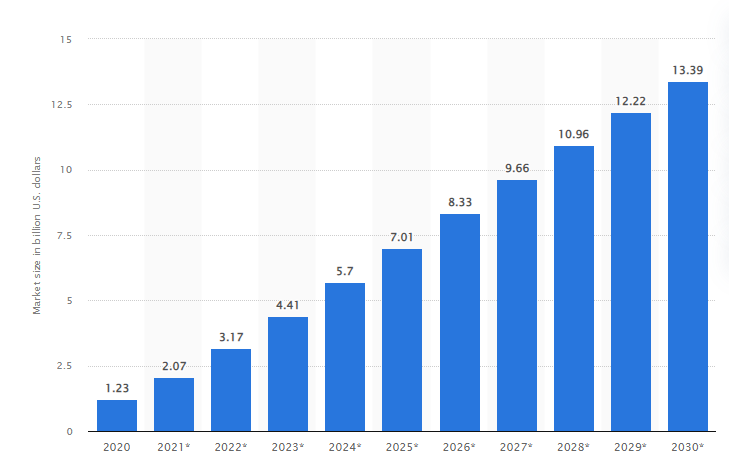
Centralizing all the BOTs developed by individual departments is important as it will definitely cut cost and lead to an uniform mechanism and process being established across the organization. Chaos is around the corner, if this is not done in time as each department will have its own guidelines with different vendors making latter integration costly and difficult.
Let us take a first look at how a RoBOTic Operations Center would look like
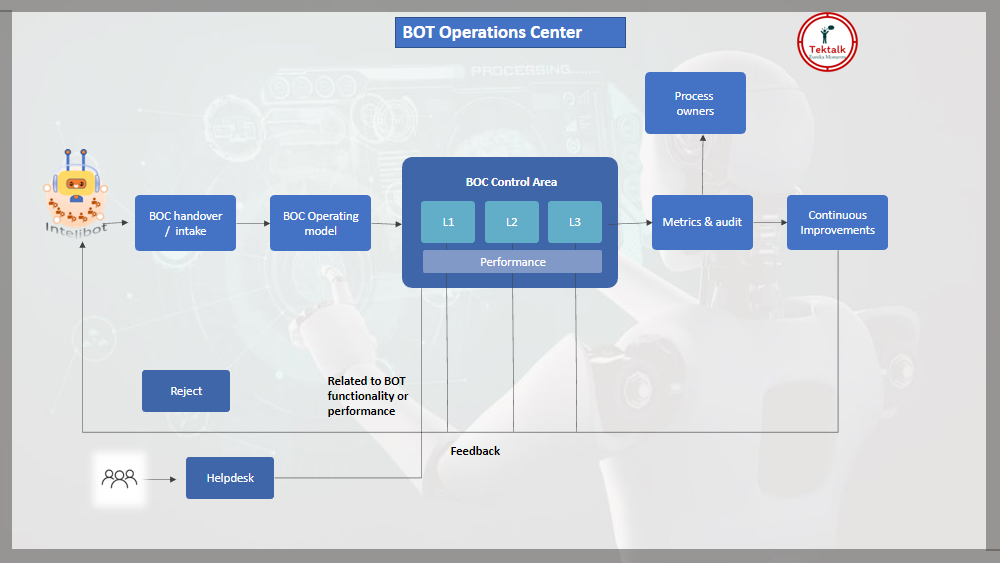
The RoBOTic Operations center (BOC) is the main center where all the developers of BOTs (Dev Teams) handover the BOTs. The center takes in the BOTs with a specific procedure and documents it. The intake of the BOTSs follows a BOC operating model that is individualistic to each organization who develop internal standards. The RoBOTic Operations Center handles various issues that are categorized as L1, L2 and L3 based on the severity of the problem. Helpdesk interacts with the RoBOTic Operations Center Control area, in taking and resolving tickets that is part of every single IT operations – in this case only related to BOTs.
Feedback on the resolution, type of resolution and how it was solved is stored as part of continuous improvement and metrics of the same are generated and sent out to process owners for further action. This center operates like any other IT Managed services, where issue resolution, problem resolution and change management are part and parcel of operations. It is important to note that feedback is captured in a structured manner so that further similar problems are averted and is passed back to the DEV teams.
Let us look at all the services that a typical BOC would provide.
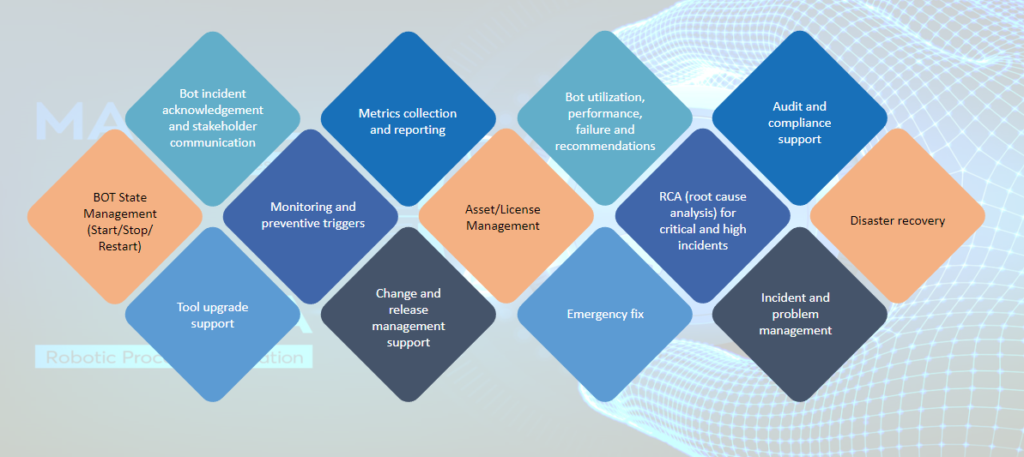
As one can see from the above, the services are listed as follows.
Start/Stop/Restart
The helpdesk provides services that includes starting, Stopping and Restarting a BOT. BOTs are like other software services, that breakdown due to various technical reasons which calls for these services. Having them centrally controlled gives the organization better control and understand the behavior over a period of time and apply remidiative measures.
We can summarize in the following diagram which are part of the IT Managed services provided internally by most organizations. Inside an organization, the customers are the respective departments.
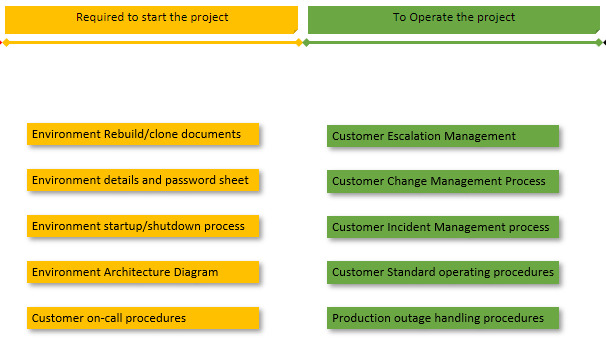
Deploy
The first step in implementation is the deployment of process bots. Start with analysis of the current environment and deploying custom bots. To deploy these bots, we need to consider every unique business environment and enable the best coding standards, practices, and security every step of the way.
- Deployment of bots to staging & production environments
- Run security scans
- Change Management
- Update configuration
- Smoke tests for validity
- Create logical points for rollbacks
Monitor
You have to monitor BOTs consistently to keep a check on performance. The BOT metrics ensures that no problem is not addressed. BOT reports with performance logs and metrics help conduct timely root cause analysis. Follow up with accurate troubleshooting to avoid bot failure and bottlenecks and ensure uninterrupted process automation.
- Proactively monitor BOT execution, gather regular metrics and watch performance
- Capacity Management – No outages because of space and memory restrictions
Bot Optimization and Maintenance
After bot deployment, monitoring and support, the maintenance and optimization is conducted. Leveraging the metrics, reports and logs to arrive at optimal bot performance. Automation engineers fix bugs and troubleshoot them. Additional bot development and testing are also carried out based on business input.
- Address fixes for minor bugs
- Address performance improvements
- Apply minor fixes to address any changes in the applications under automation
- Help with version upgrades
BOT Reporting
With consistent monitoring, maintenance and reporting, services align bot performance with business goals. The periodically generated reports, you log bot metrics, troubleshooting events, bot rejections and its reasons, bot enhancements and throughput.
- Daily, Weekly & Quarterly reports with key metrics
- Service Level Reports
- Business Analytics
- Capacity Metrics
Let us look into the details of the BOT handover Intake process
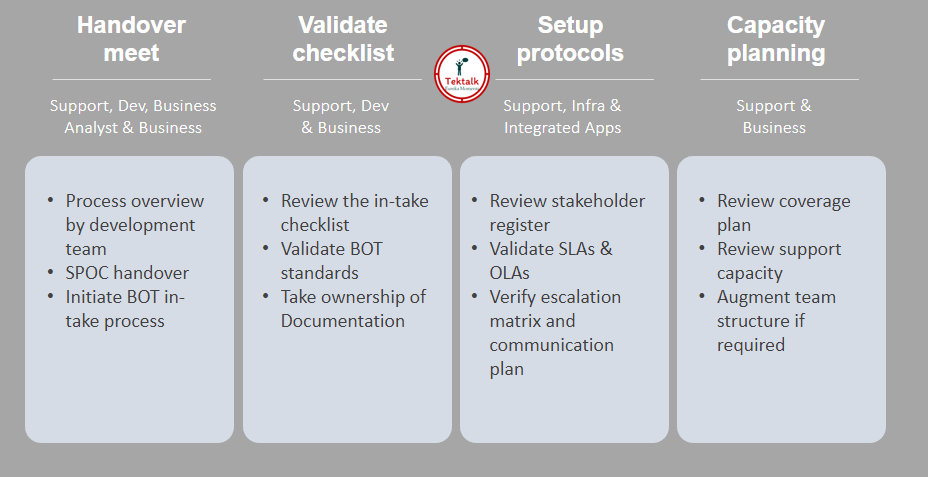
In addition to the process, we need to define the checklists for the intake. The diagram below shows the intake checklist.
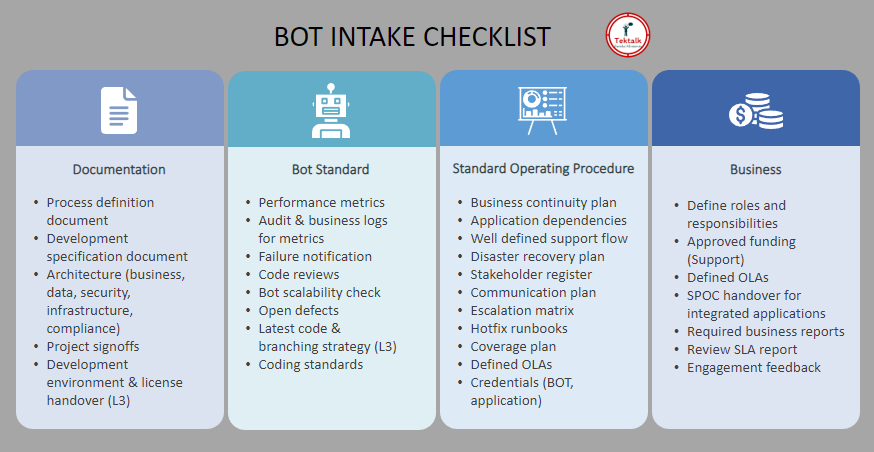
As you can see above the intake checklist is quite detailed and all the above need to be in place before the BOT is taken into the RoBOTic Operations Center.
Well, I hope you have a good idea of how to create a basic working RoBOTic Operations Center. You may expand on this to for your organization and add other custom methods that are applicable to you.
Authored By – Vijay Chander 2022


